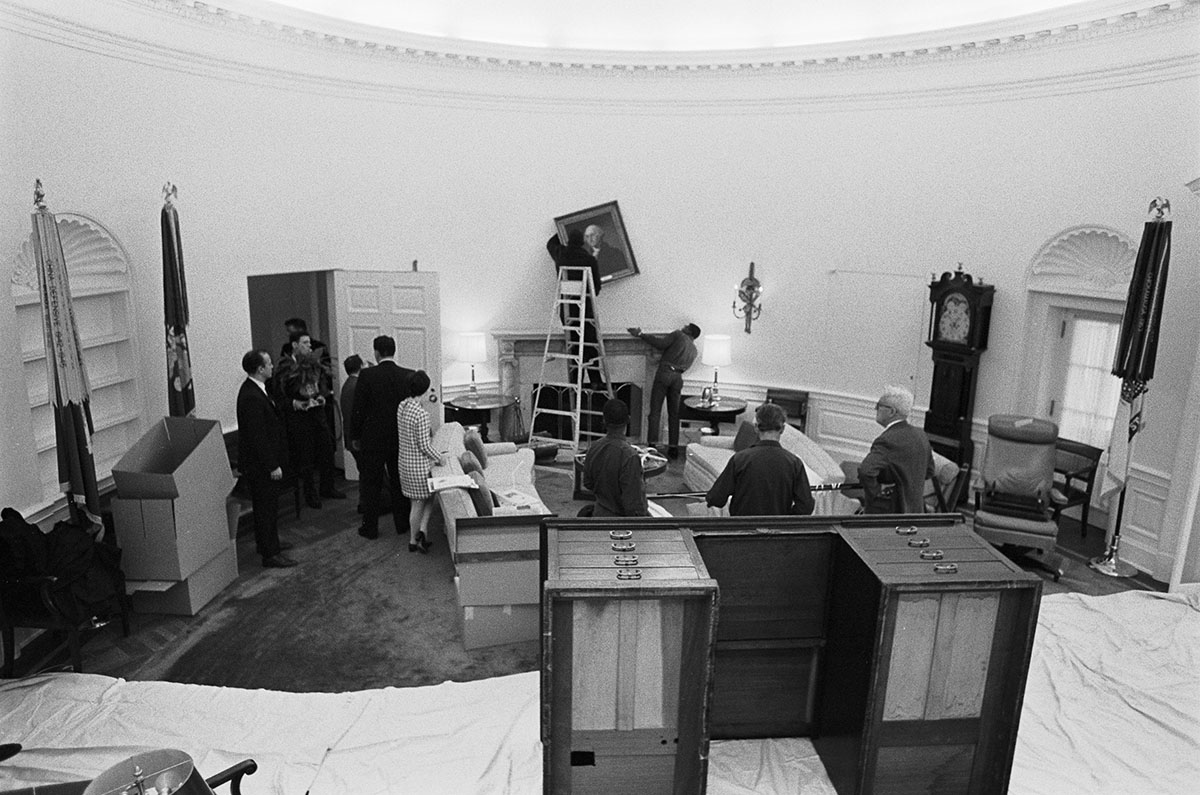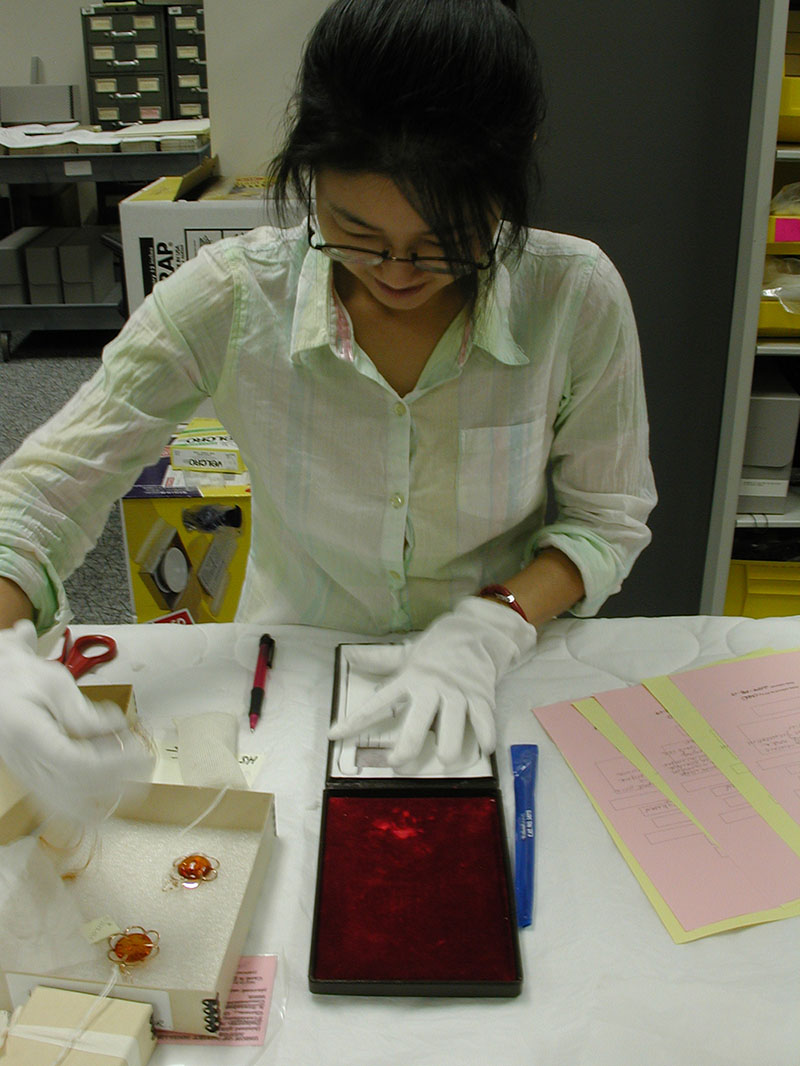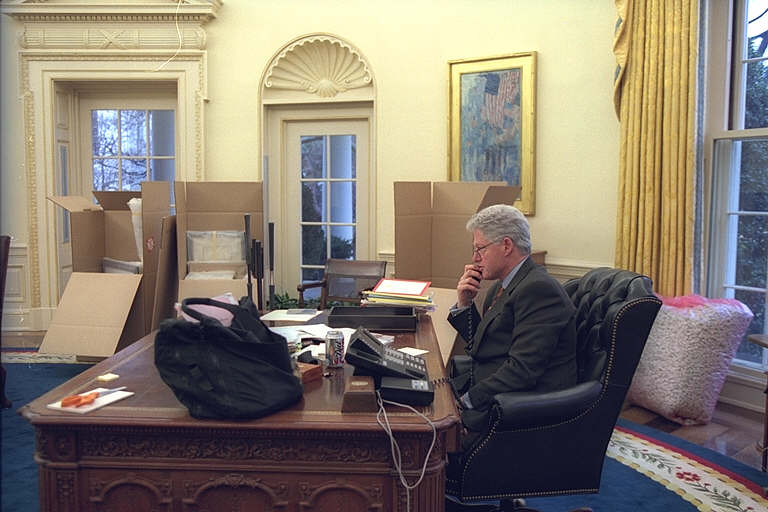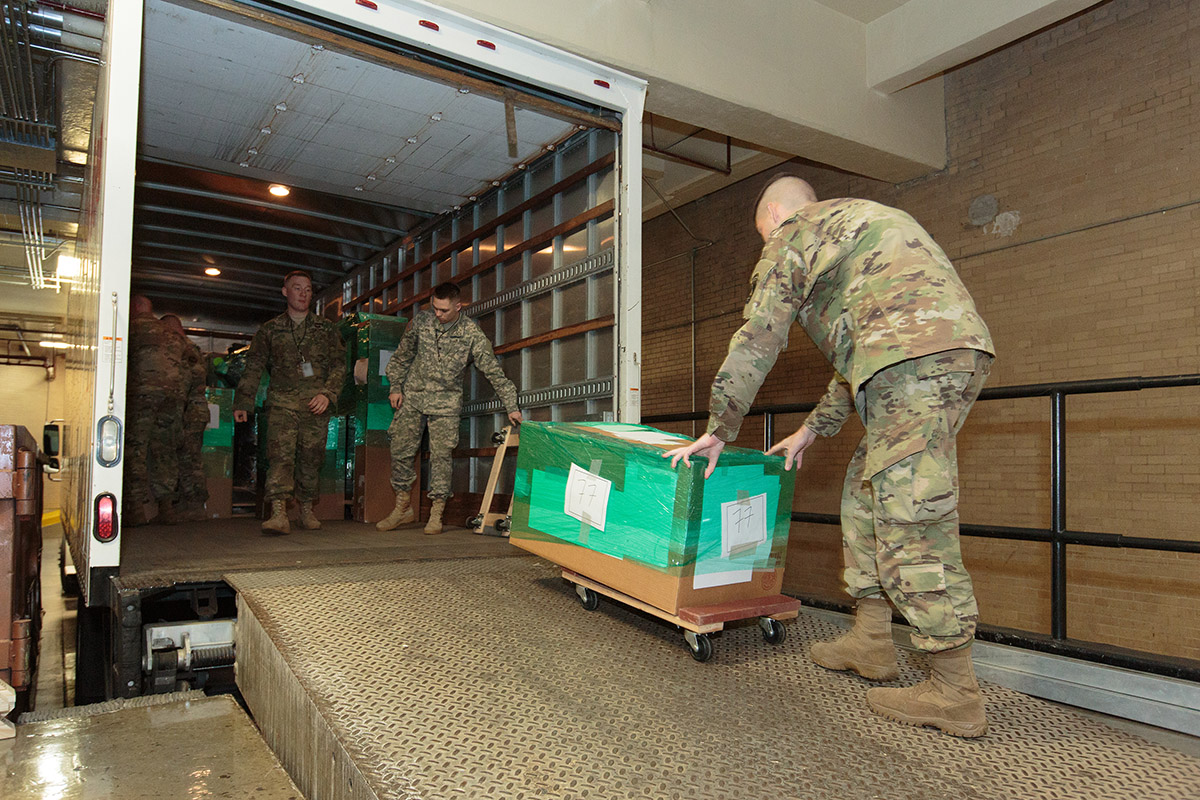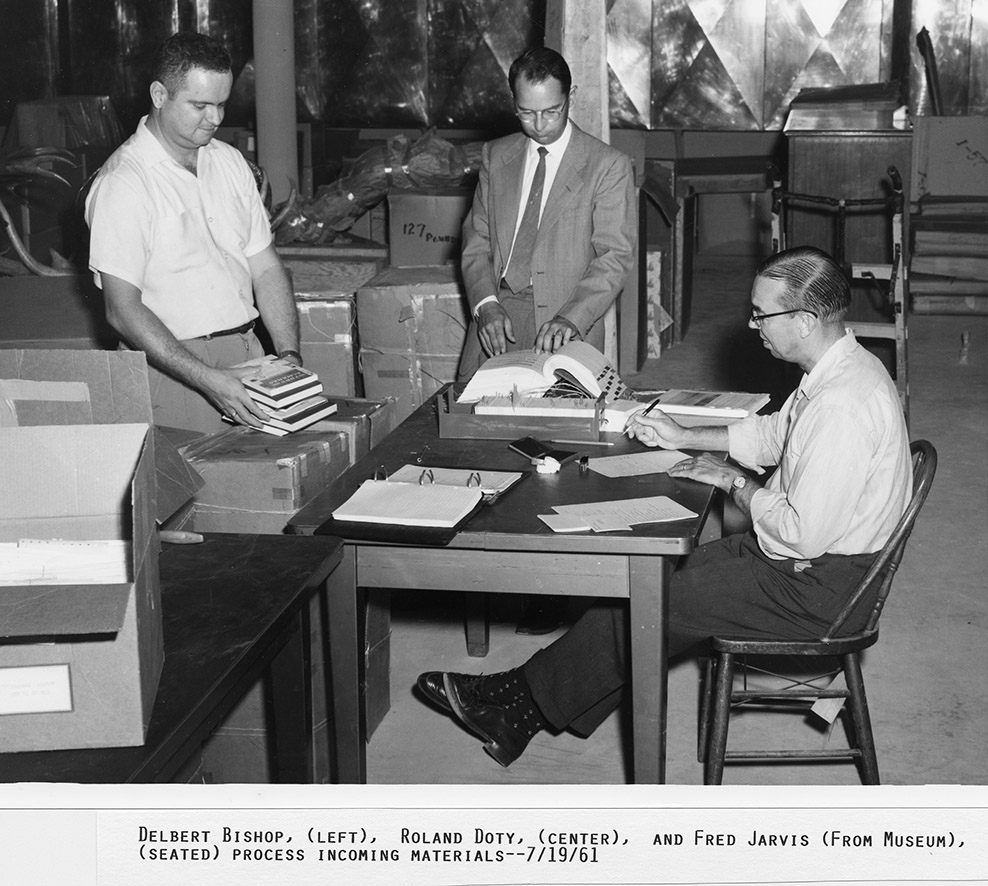
Moving Out, Moving In
The National Archives’ Important Role When the Presidency Changes Hands
Winter 2016, Vol. 48, No. 4
By David McMillen
Election evening 2016.
The votes have been counted. The winner declared. Celebrations ran well into the early morning. Now, the confetti-covered ballroom floor is empty. A few young men and women sit at tables around the edge, scribbling on napkins. The euphoric have turned somber.
“We have a government to put together,” one person says.
About 75 days after the election, the entire leadership of the executive branch is replaced. In his epic work Democracy in America, Alexis de Tocqueville called the American presidential transition a revolution caused by law. He observed that both John Quincy Adams and Gen. Andrew Jackson, our seventh and eighth Presidents, replaced all or the majority of the individuals who had been appointed by his predecessor.
De Tocqueville recognized what is often lost in today’s focus on the White House: The transition from one administration to another is a massive change affecting thousands of individuals.
For the 2016–2017 transition from Barack Obama to Donald Trump, the National Archives plays a significant role in the transition mechanisms set up by the Presidential Transitions Improvement Act of 2015 and Executive Order 13727, issued in May 2016, as well as the Presidential Records Act of 1978 as amended.
Two stories dominate coverage of a presidential transition: the overwhelming task of putting together a new administration in two and one-half months, and the complicated task of winding down and packing up an administration that has been in place for four or eight years.
The National Archives and Records Administration is a key player in both.
“The United States has always been a shining example to the rest of the world of the peaceful transfer of power every four or eight years,” said Archivist of the United States David S. Ferriero. “The National Archives is honored to play a major role in this transition process, one of the most important periods in our democracy.”
But, he noted, the process begins not on the last day of a presidency, but on the first day.
The Archives Provides Storage
As Volume of Materials Grows
From the beginning of the Obama administration, the National Archives has been assisting the White House with managing its presidential records and materials. Presidential gifts are stored at the Archives, where they are catalogued and appropriately boxed and crated. As Presidential records begin to bulge the filing cabinets at 1600 Pennsylvania Avenue and the Eisenhower Executive Office Building next door, the National Archives provides “courtesy storage” space. The artifacts and records, which remain in the legal custody of President Obama, are available to the White House upon request.
At the end of the administration, those records and gifts will be a part of the presidential materials managed by the National Archives at the Obama Presidential Library in Chicago.
Historically, as the transition in administrations draws close, the effort required of National Archives staff intensifies.
Material transferred from the White House to the National Archives at the end of an administration is measured in truckloads and terabytes.
During the Bush-Obama transition, two Boeing 747 cargo planes, a DC-8 transport, and 25 trucks moved records and gifts from Washington, D.C., to a temporary storage facility in Texas to await completion of the George W. Bush Library. That was 44,759 cubic feet of materials weighing 804,866 pounds—about the same as the weight of four Boeing 727 cargo planes.
Those records are now housed in the George W. Bush Library in Dallas, Texas, on the campus of Southern Methodist University. In addition, more than 80 terabytes of electronic files from the George W. Bush administration were moved to the National Archives repository of electronic presidential records.
During the years between the end of an administration and the opening of the presidential library, National Archives staff organizes and processes the records for access. Finding a place to store this volume of material is not always easy. It must meet the environmental and security standards for document and artifact storage set out by the National Archives. The space also must be suitable for the archivists and museum staff to do their work.
The records of the Obama administration will be housed in a converted furniture warehouse and showroom in Hoffman Estates, a suburban community about 30 miles northwest of Chicago. The Obama Library will be built in Jackson Park, about 40 miles to the southeast on Chicago’s South Side along Lake Michigan and near the University of Chicago.
Repurposed storage facilities are a trademark of temporary library locations. The records from the Reagan administration were housed in a converted pasta factory. For the records of the George H. W. Bush administration, a bowling alley and an adjacent Chinese restaurant were combined to provide space for the records. A former car dealership housed the Clinton records in Little Rock.
Gifts to Presidents Pose
A Challenge in Packing
During each administration, Presidents receive thousands of gifts from people in America and around the world. They also receive many head-of-state gifts from other countries as part of the time-honored tradition of exchanging diplomatic offerings. These foreign and domestic gifts can range from a grain of rice on which President Richard Nixon’s face was painted to a ping-pong table given to President Obama by the prime minister of the United Kingdom.
Properly packing these gifts can be difficult. One of the most unusual was a GEM car given to President George W. Bush during the 2004 G-8 Summit. Daimler Chrysler gave each head of state this electric-powered golf cart, emblazoned with each countries’ respective flags. Because of its size, the GEM car was delivered directly to the Archives instead of taking the usual route through the White House Gift Office. The most practical way to get the car into storage was to drive it down the halls of the National Archives Building to its secure holding area. Once it was time to ship the car to Texas, driving it back out was not an option as the batteries had been permanently removed for preservation purposes. Our staff built special crating with wheels to protect the car and facilitate its safe transport to the temporary site of the George W. Bush Library in Dallas.
Each move of presidential records is a larger and more complicated undertaking than the last. In the Winter 2008 issue of Prologue, Nancy Smith documents the transfers from Franklin Roosevelt’s presidency to William Clinton’s. In addition, she discusses the political and legal history of those transfers. The most obvious conclusion from Smith’s exhaustive study is that every transition is different.
The 2008 Transition:
Lessons Learned
The Bush-Obama transition after the 2008 election was one of the smoothest ever, according to the Partnership for Public Service’s Center for Presidential Transitions, a nonpartisan organization that serves as a repository of information on past transitions. President Bush instructed his staff to make sure the incoming administration had the information it needed, and President-elect Obama put his closest advisers in charge of his transition team.
Christopher Lu, Obama’s deputy secretary of the Department of Labor, served as the executive director of the Obama-Biden transition team. John Podesta, former White House chief of staff; Valerie Jarrett, a senior adviser to President Obama; and Peter Rouse, Obama’s Senate chief of staff, served as co-chairs of the transition team.
In July 2016, Lu was a key participant at a program on presidential transitions hosted by the George W. Bush Library and organized by the White House Transition Project and the Rice University Baker Institute for Public Policy. Lu summarized the tone of the forum when he said:
Planning a transition is one of these really unique experiences where you can’t ask for an extension of time. At noon on January 20, ready or not, you have to be prepared to take over. And that time goes very, very fast. And the decisions—many of the decisions that you make during the transition will ultimately affect the success of your presidency. But the key to all of this is understanding that, no matter how great the planning is, you have to be prepared for the unexpected.
At the forum, Lu stated that he began planning the transition in April 2008, almost nine months before the election, with most of the work done behind closed doors. In 2008, the public still held the notion that a candidate planning a transition was presumptuous. Nonetheless, the Obama campaign staff knew that the 75 days between the election and the inauguration was not enough time. Before the election, they identified key individuals and developed a road map to keep the process on track. After the election, the transition kicked into high gear.
The Obama transition effort had two components: a small group of senior advisers who laid out the policy directions for the new administration, and a larger group of political advisers and subject matter experts who developed materials for the incoming appointees. It is not surprising that this structure is mirrored in the President’s Executive Order 13727, which creates a structure for the current administration to manage the transition.
The day after the election, Lu and his colleagues were hard at work recruiting the subject experts needed for the effort. Two days later, the first group was assembled and given its charge to prepare the administration for the first 90 days. They looked for answers to several questions. What land mines are waiting to throw the administration off course? What potential dangers or embarrassments are out there that the agencies’ staffs won’t tell us about? Who in an agency should we go to when we need to get an answer within the hour? The first reports were due two days later, and they had until Christmas Eve to finalize their work. Most of the analysts worked 16-hour days seven days a week to meet the deadlines.
At the same time, the senior leadership of the transition team began the complicated task of developing lists of potential nominees for senior administration positions—department secretaries and under-secretaries, agency administrators, and White House senior staff. In January, the subject specialists on the transition team briefed potential nominees for those senior administration positions.
Meanwhile, back at 1600 Pennsylvania Avenue, the period between the election and the inauguration is one of packing up and closing down. Career support staff must simultaneously plan for the arrival and orientation of new staff.
As Josh Bolton, chief of staff to President George W. Bush, put it at the Bush Library conference on the transition: “It’s noon on January 20 every four years that the people who have been in charge suddenly have no authority anymore. They are done, you’re out. Your badge doesn’t work, you can’t get back into your office, nobody either expects to or should follow your instructions.”
Groundwork for the Transition
Begins Long Before January 20
For the National Archives, preparing for the White House move begins some 15 months before Inauguration Day—in some cases as far back as the first day of the presidency. Materials previously transferred to the National Archives for courtesy storage have already been boxed and organized. Archives staff must communicate with White House staff to plan and organize the final packing.
Throughout the transition, the business of government continues. Domestic policy initiatives must be managed; foreign policy issues continue to ebb and flow. The hectic pace within the White House continues unabated.
It is the National Archives’ responsibility to ensure, in addition to this already full agenda, that there is an orderly process in place to move all records and gifts remaining in the White House to the National Archives for shipment to the temporary facility in Chicago.
There are also electronic records to be transferred. It is estimated that the electronic records from the Obama administration will occupy some 200 terabytes of storage space. To put that into perspective, it is about the same as the contents of the Library of Congress or the Mikulski Archive for Space Telescopes, which holds all of NASA's optical and ultraviolet light observations from the past three decades.
Not all of the electronic records from the Obama administration are text-based. The holdings include photographs, videos, emails, maps, social media postings, and anything else that might have been stored digitally. Each different record type requires a different process for accurate and reliable transfer. While the collection of electronic records from the Obama administration is large, it is not the largest transfer of electronic records the National Archives has managed. In 2012, the Census Bureau transferred the electronic records of the 2010 census, approximately 331 terabytes.
Throughout the fall and winter of 2016, the National Archives staff has been working with the White House staff to provide for the orderly transfer of records while assuring that the records necessary to conduct the country’s business remain accessible.
In addition to managing the presidential records created in the White House, the National Archives has the responsibility to assist each of the executive branch departments and agencies in managing their records. At the end of an administration, these agencies face records management challenges as senior political appointees leave the agency.
Today, it is clear that the records of senior officials are official government records; however, this was not always the case. The records of many past cabinet secretaries are housed in the Library of Congress, in academic libraries, and in private collections.
Laws that Govern the Process
Of Presidential Transitions
Congress passed the first Presidential Transition Act in 1963 (Public Law 88-277, 3 U.S.C. 102 note) to provide public support to the incoming administration. The act charged the Administrator of the General Services Administration (GSA) to provide space for the transition staff after the election. (In 1963, the National Archives was a part of the GSA.) The act also provided modest financial support for transition activities.
Congress amended the 1963 act in 1988 to increase the funds available and to define contribution disclosure rules. Congress acted again in 2000 to provide for briefings for the incoming administration and to require the GSA, “in consultation with the Archivist of the United States,” to develop a transition directory that provides “information on the officers, organization, and statutory and administrative authorities, functions, duties, responsibilities, and mission of each department and agency.”
The 2000 amendments also charge the Office of Government Ethics to prepare a report on improving the financial disclosure process for presidential nominees.
In 2016, Congress passed legislation that significantly changed the transition process, and the President set out the mechanisms for making the legislation work.
The Presidential Transition Improvements Act and Executive Order 13727 set the stage for a significantly different transition process. The act requires “the President's annual budget request to Congress to include funding for the management and custody of Presidential records by the National Archives and Records Administration for each fiscal year in which the term of office of the President will expire.”
In 2016, each of the major candidates is provided space and support for transition planning prior to the election. Previously, space and funding was provided only to the President-elect after the election.
Executive Order 13727 also establishes a two-tier structure within the executive branch for preparing for the transition. This structure resembles one that President Obama set up for his transition—a senior-level policy group and a group of experts to make sure the policy is carried out appropriately.
In the law and the executive order, these groups are identified as the White House Transition Coordinating Council and the Agency Transition Directors Council. The National Archives sits on the Agency Council.
The White House Council is charged with providing guidance to agencies and facilitating communications between the candidate representatives and executive branch staff. The Agency Council is responsible for carrying out the policies developed by the White House Council, developing an interagency strategy for the transition, and coordinating transition activities.
Other Tools Available
For Transition Officials
As a part of this effort, the GSA, in cooperation with the National Archives and the Office of Government Ethics, has developed a Presidential Transition Directory, which is available to the public online.
The Transition Directory is a resource for incoming officials or those being considered for an appointment. It provides basic information on the structure of the federal government, ethics and human resource guidance, an overview of the transition timeline along with links to the White House and agency councils, an introduction to records management that includes guidance on both presidential and federal records, and links to external resources like the White House Transition Project and the National Academy of Public Administration.
As the transition approaches, the National Archives increases its outreach to agencies to highlight records management responsibilities. The Archives creates new guidance products for federal agencies and holds presentations and briefings at transition-related meetings and events to stress the importance of an agency-wide effort to manage agency records during the transition.
This work highlights the unique challenge of assuring that outgoing officials’ records are properly identified while introducing incoming officials to federal records management requirements. Many of the incoming officials are new to federal service, and these requirements often mean that they must learn to conduct their business differently.
The National Archives’ web publication “Documenting Your Public Service” explains the difference between federal records and personal records, discusses the role of electronic records, and describes the employee’s responsibilities when entering and leaving government service.
The publication also provides a list of resources available for more detailed information, including a one-page version of this guidance, “Records Management Guidance for Political Appointees,” and model entrance and exit records management checklists for agencies to use both during the presidential transition and throughout the tenure of the administration.
The government must continue to function seamlessly as power transfers from one administration to another. Those leaving office must leave behind all federal records created or received during their service as a federal government employee. These National Archives publications and briefings for agency officials help lay the groundwork for such a seamless transition.
Throughout a presidential transition, the National Archives assists the White House and agencies to prepare their records so that the actions of each administration are documented and available for use by historians and the public alike. The Archives also assists the incoming administration prepare for the challenges ahead.
The National Archives serves several important functions during the presidential transition as it manages loading trucks and cargo planes with documents, the accurate and secure transfer of email and other electronic records, the protection of national security information, and records management guidance for outgoing and new political appointees. However, perhaps one of the most important functions is to lay the groundwork for the next transition.
Additional Resources
A transcript of the program on presidential transitions at the George W. Bush Presidential Library is available at www.whitehousetransitionproject.org/wp-content/uploads/2016/08/Transcript-of-Conference-G.W.-Bush-Presidential-Center.pdf.
In September 2016, the Presidential Transition Project held a forum on assuring national security during a presidential transition at the Lyndon B. Johnson Library in Austin, Texas ( www.whitehousetransitionproject.org/experts-news/events/national-security-transition/).
In October 2016, at the George Bush Library in College Station, Texas, the Project held a program on crisis management during a presidential transition ( www.whitehousetransitionproject.org/experts-news/events/455-2/).
The full membership of the White House Transition Coordinating Council and the Agency Transition Directors Council can be found in the President’s executive order at www.federalregister.gov/documents/2016/05/11/2016-11300/facilitation-of-a-presidential-transition.
The Presidential Transition Directory is at https://presidentialtransition.usa.gov/.
The National Archives web publication “Documenting Your Public Service” can be found at www.archives.gov/records-mgmt/publications/documenting-your-public-service.html. A one-page version of this guidance, “Records Management Guidance for Political Appointees,” is available at www.archives.gov/files/records-mgmt/publications/rm-for-political-appointees.pdf.
